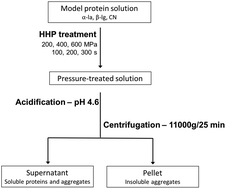当前位置:
X-MOL 学术
›
Green Chem.
›
论文详情
Our official English website, www.x-mol.net, welcomes your
feedback! (Note: you will need to create a separate account there.)
The use of high hydrostatic pressure to modulate milk protein interactions for the production of an alpha-lactalbumin enriched-fraction
Green Chemistry ( IF 9.3 ) Pub Date : 2017-12-12 00:00:00 , DOI: 10.1039/c7gc03428h Alice Marciniak 1, 2, 3, 4, 5 , Shyam Suwal 1, 2, 3, 4, 5 , Michel Britten 5, 6, 7 , Yves Pouliot 1, 2, 3, 4, 5 , Alain Doyen 1, 2, 3, 4, 5
Green Chemistry ( IF 9.3 ) Pub Date : 2017-12-12 00:00:00 , DOI: 10.1039/c7gc03428h Alice Marciniak 1, 2, 3, 4, 5 , Shyam Suwal 1, 2, 3, 4, 5 , Michel Britten 5, 6, 7 , Yves Pouliot 1, 2, 3, 4, 5 , Alain Doyen 1, 2, 3, 4, 5
Affiliation

|
Disposal of whey, a co-product generated from the dairy industries, remains an important worldwide problem. However, considering its composition in high value proteins, some technological strategies have emerged for its optimal valorization. Separating alpha-lactalbumin (α-la) from beta-lactoglobulin (β-lg), the two major whey proteins (WP), remains quite challenging to scale up especially using eco-efficient technology due to their similar molecular weights. As a novel approach, we proposed to improve the fractionation of these WP and the recovery of α-la, using high hydrostatic pressure (HHP), an emerging and green technology, combined with acidification to pH 4.6. For this, model protein solutions containing α-la, β-lg and casein (CN – isoelectric, IC and micellar, MC) were treated by HHP and acidified to pH 4.6, with the aim of optimising HHP parameters (level of pressure and time) and the type of CN. The pressure treatment rendered β-lg insoluble forming aggregates with CN and precipitates after acidification to pH 4.6, while α-la remained soluble. Analysis of pressure-treated solutions before acidification showed two main categories of generated-aggregates: (1) κ-CN, αs2-CN and a large portion of β-lg, mainly linked via disulfide bonds, and (2) αs1-CN, αs2-CN, β-CN and a small amount of β-lg, supposedly linked through hydrophobic interactions. The pressure/time combination of 600 MPa/300 s generated the highest α-la purification degree (86%) and protein recovery (77%) using IC. Our experiments, performed on model dairy solutions, demonstrated that the HHP-based fractionation process could be employed in dairy whey processing for the recovery of highly valuable proteins such as α-la.
中文翻译:

使用高静水压力来调节乳蛋白相互作用,以生产富含α-乳白蛋白的馏分
乳清(乳制品工业产生的副产品)的处置仍然是一个重要的全球性问题。然而,考虑到其在高价值蛋白质中的组成,已经出现了一些技术策略以实现其最佳增值。从两种主要的乳清蛋白(WP)中分离α-乳白蛋白(α-la)和β-乳球蛋白(β-lg),由于分子量相似,尤其是使用生态高效的技术进行规模放大仍具有很大的挑战性。作为一种新方法,我们建议使用新兴的绿色技术高静水压(HHP)和酸化至pH 4.6来提高这些WP的分馏率和α-la的回收率。为此,使用HHP处理包含α-la,β-lg和酪蛋白(CN –等电,IC和胶束,MC)的模型蛋白质溶液,并酸化至pH 4.6,目的是优化HHP参数(压力和时间水平)和CN的类型。加压处理使β-Ig不溶,与CN形成聚集体,酸化至pH 4.6后沉淀,而α-Ia保持可溶。酸化之前对压力处理过的溶液的分析显示,生成的聚集体主要分为两类:(1)κ-CN,αS2 -CN和大部分β-LG的,主要与通过二硫键,和(2)α S1 -CN,α S2 -CN,β-CN和少量β-LG,通过疏水性相互作用假想连接。使用IC,600 MPa / 300 s的压力/时间组合产生了最高的α-la纯化度(86%)和最高的蛋白质回收率(77%)。我们在模型乳制品解决方案上进行的实验表明,基于HHP的分馏工艺可用于乳清乳清加工中,以回收高价值的蛋白质(例如α-la)。
更新日期:2018-01-22
中文翻译:

使用高静水压力来调节乳蛋白相互作用,以生产富含α-乳白蛋白的馏分
乳清(乳制品工业产生的副产品)的处置仍然是一个重要的全球性问题。然而,考虑到其在高价值蛋白质中的组成,已经出现了一些技术策略以实现其最佳增值。从两种主要的乳清蛋白(WP)中分离α-乳白蛋白(α-la)和β-乳球蛋白(β-lg),由于分子量相似,尤其是使用生态高效的技术进行规模放大仍具有很大的挑战性。作为一种新方法,我们建议使用新兴的绿色技术高静水压(HHP)和酸化至pH 4.6来提高这些WP的分馏率和α-la的回收率。为此,使用HHP处理包含α-la,β-lg和酪蛋白(CN –等电,IC和胶束,MC)的模型蛋白质溶液,并酸化至pH 4.6,目的是优化HHP参数(压力和时间水平)和CN的类型。加压处理使β-Ig不溶,与CN形成聚集体,酸化至pH 4.6后沉淀,而α-Ia保持可溶。酸化之前对压力处理过的溶液的分析显示,生成的聚集体主要分为两类:(1)κ-CN,αS2 -CN和大部分β-LG的,主要与通过二硫键,和(2)α S1 -CN,α S2 -CN,β-CN和少量β-LG,通过疏水性相互作用假想连接。使用IC,600 MPa / 300 s的压力/时间组合产生了最高的α-la纯化度(86%)和最高的蛋白质回收率(77%)。我们在模型乳制品解决方案上进行的实验表明,基于HHP的分馏工艺可用于乳清乳清加工中,以回收高价值的蛋白质(例如α-la)。











































 京公网安备 11010802027423号
京公网安备 11010802027423号